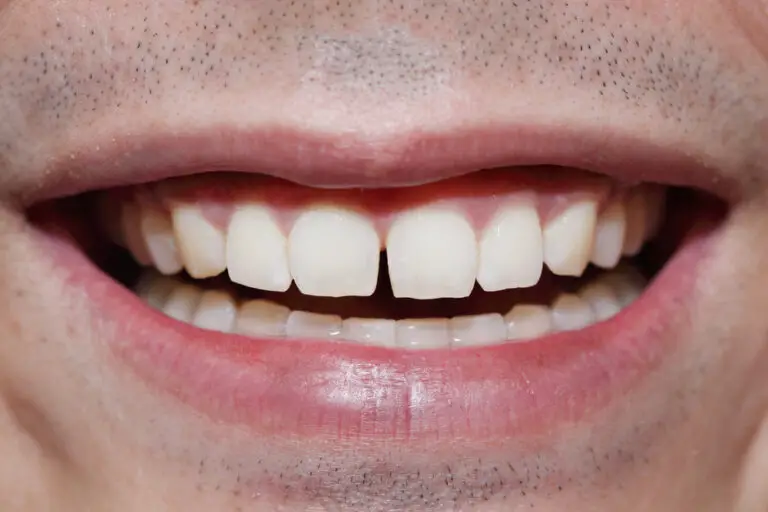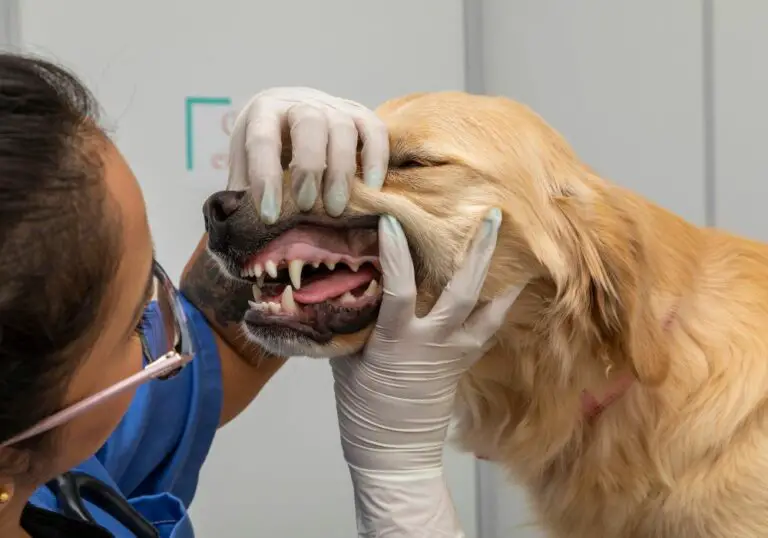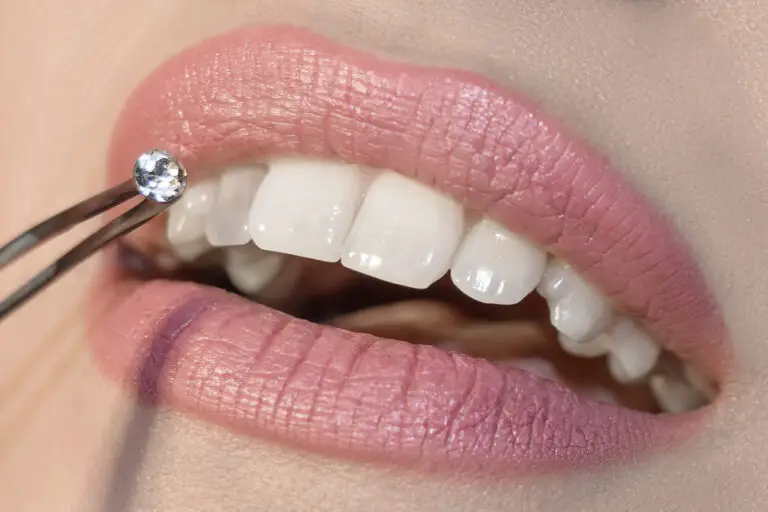Key Points
- Teething gels are generally not recommended for newborns less than 4 months old.
- Newborns may exhibit teething symptoms like excessive drooling and chewing behaviors very early on, but this is not caused by teeth pushing through the gums.
- Alternative teething remedies like cold washcloths, chilled teething rings, and gentle gum massages can provide relief for newborns.
- Consult your pediatrician before using any teething gels or medications for babies under 4 months old.
Teething is a natural part of every baby’s development that typically begins around 6 months of age. However, some newborns start showing early symptoms like increased saliva production, mouthing behaviors, and irritability within the first weeks or months after birth. Since their teeth have not broken through the gums yet, can these young infants get relief from teething gels and medications?
When do babies usually start teething?
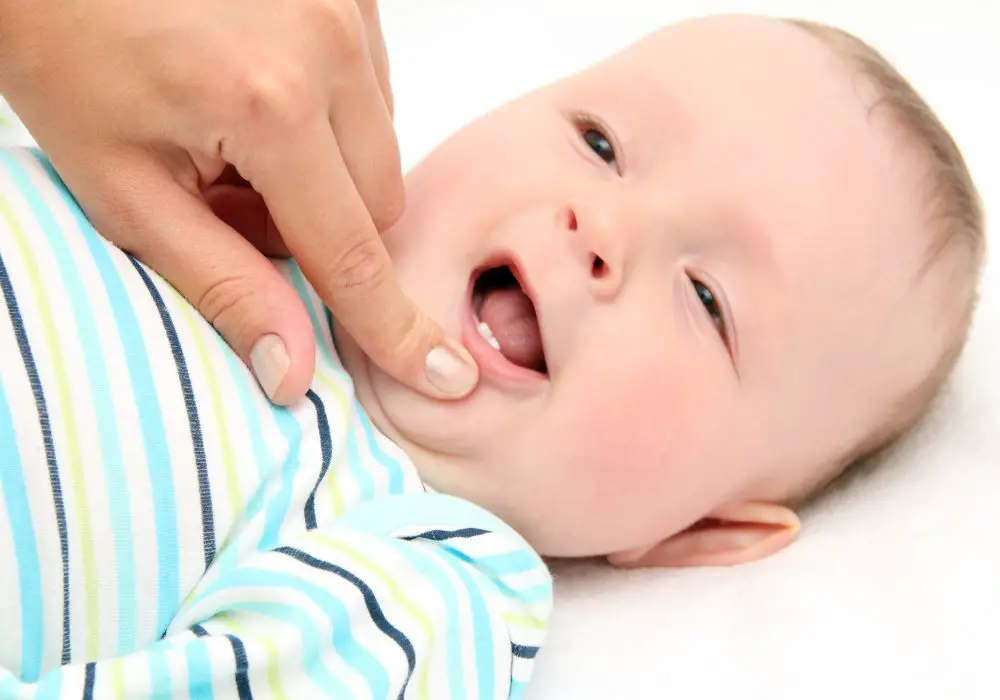
While most babies get their first teeth around 6 months, teething can start as early as 3 months or be delayed until 12, 15 or even 24 months in some babies. Every infant develops at their own pace when it comes to getting their first teeth.
The first teeth to emerge are usually the central incisors on the lower gum, erupting between 6 to 10 months of age. After that, a typical teething timeline includes:
- Lower central incisors: 6 to 10 months
- Upper central incisors: 8 to 12 months
- Lower lateral incisors: 9 to 13 months
- First molars: 13 to 19 months
- Upper lateral incisors: 10 to 16 months
- Upper canines (cuspids): 16 to 22 months
- Second molars: 20 to 31 months
While this timeline provides averages, some infants are born with one or more teeth already emerged called natal teeth. Having teeth at birth is not common, occurring in about 1 in every 2,000 to 3,000 newborns.
What are some early teething symptoms in newborns?
Many newborn babies start exhibiting behaviors like increased drooling, mouthing, and fussiness very early on, long before any pearly whites have popped through their tender gums. Some common early symptoms that may make parents wonder if their infant is already teething include:
- Greater production of saliva leading to excessive drooling, damp clothing, and dribbling
- Repeated chewing motions, mouthing, and gnawing on their fingers, fists, toys, clothing, and other objects
- Tender, swollen, or inflamed gums
- General irritability, crying more than usual, and difficulty sleeping
- Rubbing their face, ears, cheeks, and chin
- Loss of appetite and difficulty feeding or breastfeeding
- Low grade fever due to inflamed gums
- Loose stools from swallowing excess saliva
While these behaviors resemble classic teething symptoms, they are actually perfectly normal and expected developmental stages in newborns. The increased saliva helps lubricate and exercise their jaw muscles to prepare for speech and eating. Chewing motions satisfy the infant’s natural urge to gnaw as the nerves in their gums develop. Irritability can arise from the overwhelming new sights, sounds, and sensations they are experiencing every day.
True teething symptoms result directly from the pressure of a tooth cutting through the gums. Since newborns do not have any teeth under the gums yet, early symptoms are likely due to general growth rather than actual teething pain and discomfort. However, parents sometimes mistake this normal fussiness for a sign their baby is teething and reach for teething gels to relieve the infant’s distress.
What risks are associated with using teething gels in newborns?
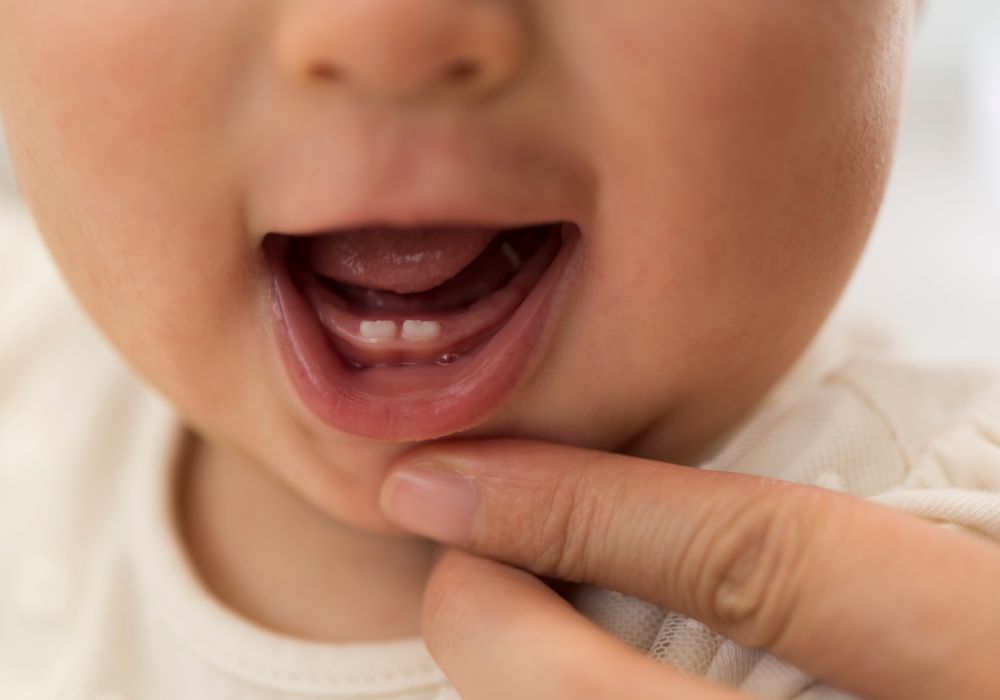
Teething gels are generally not recommended for babies less than 4 months old because the active ingredients may pose certain health risks to very young infants. Here are some of the concerns with using teething gels before 4 months:
Benzocaine risks
Benzocaine is a common pain relieving ingredient found in many popular teething gels and medications. It works by temporarily numbing or reducing sensitivity in the gums. However, benzocaine carries some safety concerns:
- Methemoglobinemia – benzocaine can interfere with oxygen transport in the bloodstream. This is a rare but dangerous side effect.
- Choking hazard – since the gels numb the throat and gums, babies may accidentally swallow too much.
- Skin irritation – some babies may experience contact dermatitis, rashes, or irritation on the gums and lips.
- Allergic reactions – while rare, some infants have benzocaine allergies.
Due to these potential risks, the FDA warns against using benzocaine-containing teething products in children under 2 years old unless advised by a doctor or dentist.
Belladonna toxicity
Belladonna is a plant with toxins that is sometimes diluted and used in homeopathic teething products. The FDA warns against using these belladonna teething tablets and gels because the amount of active toxins can vary. Too much belladonna can be very dangerous to infants.
Essential oil dangers
Some teething gels include soothing essential oils like clove, peppermint, and eucalyptus. But the concentrated oils can irritate mucous membranes and skin when used internally in babies. Their safety when applied to the gums of newborns is also unknown.
Other concerns
Chamomile and other herbs may provoke allergic reactions in some infants. Non-toxic teething gels may still contain other ingredients that have not been studied for safety in babies under 4 months old. Applying any gel too liberally also risks accidental ingestion and overdose.
For all these reasons, pediatricians recommend avoiding teething gels altogether for newborns and trying safer alternative remedies to relieve any discomfort instead. If your infant’s irritation persists, contact your doctor to discuss options.
What are some alternative teething remedies for newborns?
While numbing gels provide targeted pain relief where teeth are erupting through sore gums, they carry risks in babies under 4 months that parents may want to avoid. Some safer ways to relieve early teething discomfort in newborns include:
Cool washcloth
- Run a soft washcloth under cool water and gently rub on the sore gum area. The cold temperature helps numb and soothe inflamed areas.
Cold pacifier or spoon
- Place a rubber teething pacifier or spoon in the refrigerator (not freezer) for a chilling effect. Allow your baby to safely suck and gnaw on the chilled rubber surface.
Rubber teething toys
- Look for BPA-free rubber or silicone teething toys meant for young infants. The cool texture and flexibility provide relief for tender gums.
Cold fruits or vegetables
- A chilled piece of banana, apple, or carrot can let sore gums safely gnaw and massage the area. Always monitor for choking hazards.
Light gum massage
- Use a clean finger to gently rub swollen and painful gums. Apply slight pressure to ease irritation, but never rub too firmly.
Increased nursing
- Breastfeeding provides close comforting contact. Breastmilk also contains antibodies that promote healing. Nurse more frequently for a teething infant.
Always keep a very close eye on babies when using any objects for teething relief. Avoid frozen or extremely hard surfaces that could injure their delicate gums. Seek medical advice if discomfort persists despite these remedies.
When is it safe to start using teething gels and medication?
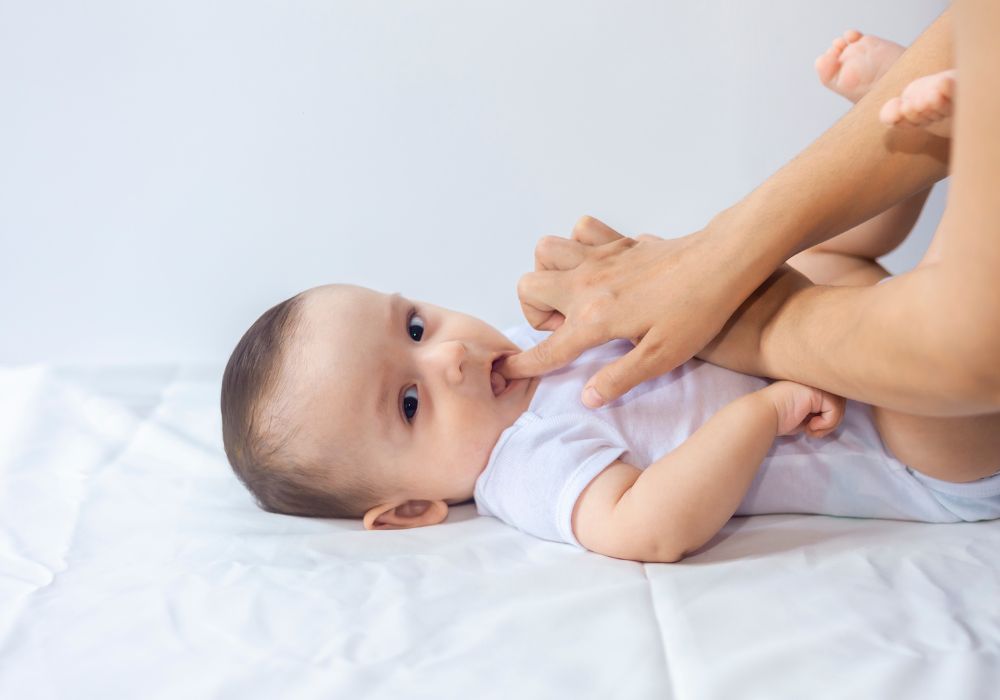
The American Academy of Pediatrics recommends parents consult their pediatrician before using any kind of teething medication, gel, or numbing agent on children under 4 months old. Most doctors advise waiting until:
- The baby is at least 4 months of age
- Teeth have actively begun pushing through the gums and erupting
- Significant discomfort is evident during teething phases
Once your child meets these criteria, look for over-the-counter teething products that are:
- Clearly labeled for babies over 4 months old
- Free from benzocaine, belladonna, and essential oils
- Non-toxic, hypoallergenic, and BPA-free
Only apply gels very sparingly by gently rubbing directly on the sore gum areas as needed. Take care not to use over large areas which could lead to accidental swallowing and ingestion.
For severe teething pain in babies over 6 months old, ask your pediatrician about using OTC pain relievers like acetaminophen or ibuprofen. These must be measured precisely based on the infant’s weight and age. Teething tablets may also be an option, but discuss these medications with your doctor first.
Seeking professional dental care for babies
The American Dental Association recommends babies have their first dentist visit by 12 months of age or within 6 months of getting their first tooth. This initial dental visit allows the dentist to:
- Do an oral exam to check for dental health problems
- Assess teeth alignment and jaw/bite development
- Provide tips for parents on caring for emerging teeth
- Clean teeth and apply topical fluoride varnish if needed
Early dental visits help identify issues like tooth decay, crowding, or bite problems that should be addressed right away. Catching and treating any problems early on improves outcomes and prevents more extensive dental work later. If parents notice any dental abnormalities in the baby teeth, see a pediatric dentist promptly. Do not wait until all primary teeth finish coming in.
Summary of key points
- Teething gels pose safety risks and are not recommended for infants under 4 months old.
- Alternative remedies like cool washcloths, chilled rubber teethers, and light gum massages can soothe newborn discomfort.
- Look for gels approved for babies 4+ months and avoid benzocaine.
- Consult your pediatrician or dentist for advice on teething treatments.
- Schedule your baby’s first check-up by 12 months old or when the first tooth erupts.
- While early fussiness may seem like teething, be patient. Letting natural teething take its course is ideal.
Work closely with your child’s doctor and dentist to find the safest pain relief methods. Avoid resorting to risky teething gels too early. With attentive care and time, your baby will soon have their first tooth!
Frequently Asked Questions
1. Why does my newborn have so much drool and chewing behavior if they don’t have teeth?
Increased drooling and chewing motions are developmentally normal in newborns and not necessarily signs of teething pain. Babies explore objects by putting them in their mouths. Extra saliva also helps exercise their jaw muscles in preparation for eating. While it may resemble teething, it is just a normal stage of growth.
2. What teething meds can I use for a 2 month old baby?
Teething medications are typically not recommended for infants under 4 months old. Chilled teething toys, cool washcloths, gum massages, and nursing can provide comfort without medicine risks. Always consult your pediatrician before using any gels, tablets, or pain relief on babies under 4 months.
3. Are teething powders with belladonna safe for a 3 month old infant?
The FDA advises not using belladonna-containing teething products in babies under 2 years old. Since the belladonna levels may vary in powders, they could pose a safety risk at just 3 months old. Instead try chilled rubber teethers, pacifiers, or gum massages for relief. See your pediatrician if discomfort persists.
4. When should I schedule my newborn’s first dental visit?
Pediatric dentistry experts recommend bringing your baby for their first dental visit either by 12 months of age or within 6 months of getting their first tooth. This allows the dentist to examine them early for potential issues and provide guidance on caring for new teeth as they come in.
5. Can I rub whiskey on my 1 month old’s irritated gums to help with teething pain?
No, you should never rub alcohol like whiskey or any spirits directly on a baby’s gums. The high alcohol content can quickly get absorbed into the bloodstream and intoxicate an infant. It can also burn and irritate delicate gums and oral tissue. Use safer natural remedies and see your doctor if pain continues.

